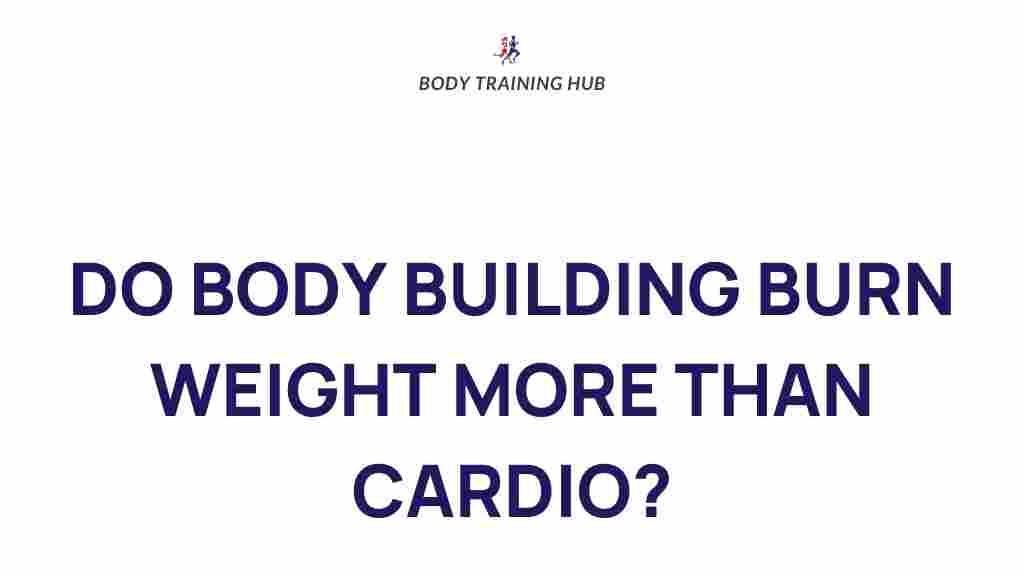Unveiling the Truth: Do Bodybuilders Burn Weight More Than Cardio Enthusiasts?
When it comes to fitness and weight loss, two primary camps emerge: bodybuilders who focus on strength training and muscle gain, and cardio enthusiasts who favor aerobic exercise. Many individuals question, “Who burns more weight?” This article aims to unveil the truth behind bodybuilding, weight loss, and cardio, exploring the myths and facts surrounding these two popular exercise modalities. We will delve into how muscle and fat interact, the science of calorie burning, and what this means for your fitness journey.
The Basics of Weight Loss
Weight loss fundamentally comes down to one principle: caloric deficit. This means you need to burn more calories than you consume. Both bodybuilding and cardio can contribute to this deficit, but they do so in different ways. Understanding these differences can help you make informed decisions about your fitness routine.
Caloric Burn: Bodybuilding vs. Cardio
When comparing bodybuilding and cardio in terms of caloric burn, it’s essential to understand how each method affects your body:
- Bodybuilding: Primarily focuses on strength training, which builds muscle. Muscle tissue has a higher metabolic rate than fat tissue, meaning that even at rest, bodybuilders may burn more calories.
- Cardio: Involves aerobic exercises like running, cycling, or swimming, which typically burn more calories during the session compared to lifting weights. However, the calorie burn stops when you stop exercising.
Myth vs. Fact: Bodybuilding and Cardio
There are numerous myths associated with bodybuilding and cardio when it comes to weight loss. Let’s clarify some of the most common misconceptions:
- Myth 1: Cardio is the only way to lose weight.
- Fact: While cardio is effective for burning calories, bodybuilding also plays a crucial role in weight loss by increasing muscle mass, which in turn boosts your basal metabolic rate.
- Myth 2: Bodybuilders don’t do cardio.
- Fact: Many bodybuilders incorporate cardio into their routines to enhance overall fitness and aid in fat loss.
- Myth 3: More muscle means more fat.
- Fact: Muscle helps to burn fat, and a well-rounded fitness program includes both strength training and cardiovascular exercise.
Understanding Muscle and Fat
To fully comprehend the dynamics of weight loss, it’s vital to differentiate between muscle and fat:
- Muscle: Denser than fat, muscle takes up less space in the body. Increased muscle mass can lead to a toned appearance and improved metabolic rate.
- Fat: While essential for energy storage and hormone regulation, excess fat can lead to health issues. The goal should be to reduce fat while preserving muscle.
How Bodybuilding Affects Weight Loss
Bodybuilding can be an effective strategy for weight loss. Here’s how:
- Increased Muscle Mass: As you build muscle, your body requires more energy to maintain that muscle, leading to increased calorie burn.
- Afterburn Effect: Known as excess post-exercise oxygen consumption (EPOC), strength training can lead to additional calorie burn long after your workout is done.
- Improved Body Composition: Bodybuilders focus not just on weight loss but on changing body composition—reducing fat while increasing muscle mass.
How Cardio Affects Weight Loss
Cardio is also effective for weight loss, particularly for burning calories. Here’s how it contributes:
- Immediate Caloric Burn: Cardiovascular exercises burn calories during the workout, making them effective for quick weight loss.
- Improved Cardiovascular Health: Cardio strengthens the heart and lungs, contributing to overall fitness.
- Variety of Options: From running to swimming, cardio offers numerous ways to keep workouts exciting and enjoyable.
Creating a Balanced Fitness Routine
To maximize weight loss and overall fitness, consider a balanced approach that includes both bodybuilding and cardio. Here’s a step-by-step guide:
Step 1: Set Clear Goals
Identify your primary goal. Are you looking to lose weight, build muscle, or improve overall fitness? Your goals will dictate your training focus.
Step 2: Combine Strength Training and Cardio
A well-rounded routine might look like this:
- Strength training 3-4 times a week
- Cardio 2-3 times a week
- Rest days for recovery
Step 3: Monitor Your Diet
Nutrition plays a vital role in weight loss. Focus on a balanced diet rich in:
- Lean Proteins
- Whole Grains
- Fruits and Vegetables
- Healthy Fats
Step 4: Track Your Progress
Use fitness apps or journals to monitor your workouts and dietary habits. Tracking progress can help you stay motivated and adjust your routine as needed.
Troubleshooting Common Issues
As you embark on your fitness journey, you may encounter challenges. Here are some tips for overcoming common issues:
- Plateaus: If your weight loss stalls, consider adjusting your calorie intake or changing your workout routine.
- Fatigue: Ensure you’re getting enough rest and recovery time. Overtraining can hinder progress.
- Lack of Motivation: Join a fitness community or find a workout buddy to keep you accountable and motivated.
Conclusion: Finding Your Path
In the debate of bodybuilding vs. cardio for weight loss, the truth is that both can be effective. Bodybuilders may burn weight more sustainably through increased muscle mass and the afterburn effect, while cardio enthusiasts excel in immediate caloric burn. The best approach is to find a balance that caters to your personal fitness goals and preferences.
Embrace the myths and facts of bodybuilding and cardio, and remember that each individual’s journey is unique. Whether you’re lifting weights or hitting the treadmill, consistency and dedication are key. For more insights on fitness, check out this comprehensive guide on exercise and nutrition. Let the journey to a healthier you begin!
This article is in the category Myths & Facts and created by BodyTraining Team
